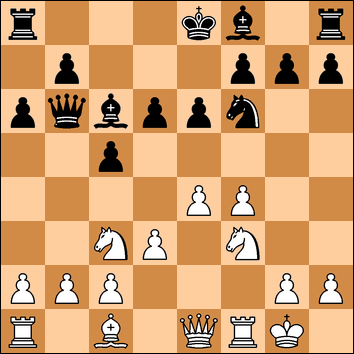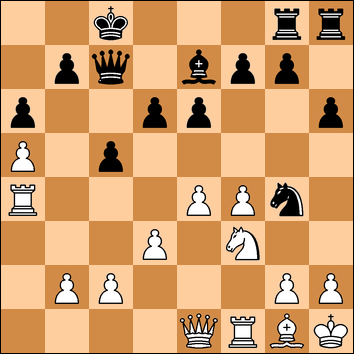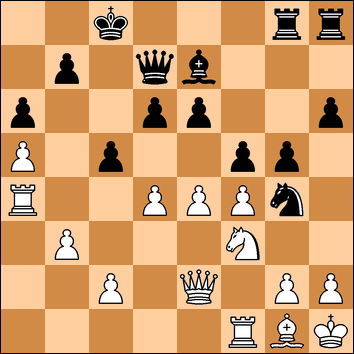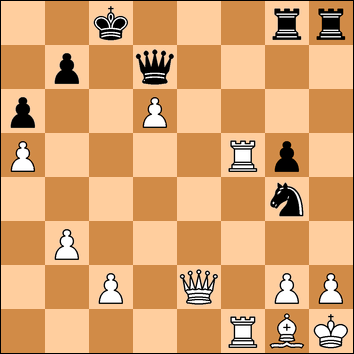Thursday 30 November 2016
White: K. Nevols (134) - Black: S. Pike (142)
My first visit to Medway Chess Club, a neat little building tucked away just behind Rainham train station.
1. e4 c5
2. Nc3
A Closed Sicilian. I think this is more in my style. The labyrinth of complications of the Open Sicilian are not for me and using this system I can build up and develop at my own pace.
2. .... d6
3. f4 Nf6
4. Nf3 Nc6
5. Bb5
In this opening I have been varying the placement of my kings' bishop as I have not quite yet decided whether it is better to go to b5 and get exchanged or to sit on e2 and get in the way.
5. .... Bd7
6. O-O a6
7. Bxc6
The move 7. Be2 is equal but I decided to remove the knight this time.
7. .... Bxc6
This is the main problem - the bishop arrives on c6 - and White's king often ends up on h1.
8. d3
The possibility of an initiative based around d5 gives Black a tiny edge. On the other hand, he has development problems with his own king's bishop.
8. .... e6
I sometimes find that a drawback of this opening is that it is difficult to form a plan until we know what Black will do with his King. Maybe an idea for White here is to exploit the small advantage in development with a quick 9. e5. Black might not want to open the f-file with 9. ... dxe5 10. fxe5 Nd7 and might just retreat with an immediate 9. .. Nd7.
Instead I prefer to just keep moving about and wait.
9. Qe1 Qb6

Now an interesting move would be 10. f5!? One line is 10... c4+ 11. Kh1 cxd3 12. cxd3 exf5 13. e5! or 12. ... e5 13. Qe2 with Be3 to follow.
If instead 10. f5 e5 then simply 11. Rb1 preparing either Be3 or Bg5. And if 10. f5 exf5 then not 11. exf5+ Be7 but 11. e5 with a better position.
I did think about the flashy 10. Nd5?! but then 10. .. Nxd5 11. exd5 Bxd5 just loses a pawn.
Instead no need for heroics - just tuck the king away.
10. Kh1 O-O-O
A surprise. I had expected 10. ... Be7 with kingside castling. Now that Black has chosen where to place the king, I can start thinking about a plan. A good point about this opening system is that it leaves open the option of attacking on either wing. Expanding on the queenside now seemed a good idea.
11. a4 Qc7
12. a5 h6
Presumably to guard against Ng5 although I wasn't thinking about that.
13. Be3
Black's best move now would be to counter in the centre with 13. .. d5! - the initiative I mentioned earlier. 14. exd5 exd5 would free up Black's position and give him ideas of a future Bd6 and Rhe8. Whereas if White wanted to keep the position closed with 14. e5 then Black could play 14. .. d4 15. exf6 gxf6! 16. Bc1 dxc3 17. Qxc3 Be7. The Bishop on c6 and the possibility of an attack down the g-file gives Black a clear advantage.
With all this in mind, the more modest 13. Bd2 might have been better.
13. .... Be7
Opening lines with 14. b4!? might be interesting. However I wanted to get rid of that bishop on c6.
14. Na4 Bxa4
This capture is not forced - 14. ... Kb8 is quite adequate - but White is playing a piece of bluff. a white knight on b6 looks more scary than it actually is.
15. Rxa4 Ng4
16. Bg1
I didn't want to lose this bishop just yet. I am still thinking about how I can get a b4 move in.
16. .... Rdg8?!
A surprise. Black clearly decides against any central play and decides on an offensive on the kingside. However he does not have the time for this. 16. .. d5 or just 16. .. Nf6 is better - and the game remains equal.

17. Qe2!
A multipurpose move - it protects the c4 square so I can play d4 - it defends the second rank - and it gives room to move the other rook out to join in a queenside offensive.
17. .... Qd7
18. b3
The rook is in a good position so I did not want to move it back.
18. .... f5
And now Black begins his attack. I had some thought and decided my pieces were well placed if the centre should come open.
19. d4
A much better move is 19. e5!
If 19. ... d5 then 20. h3 h5 21. Ng5 with advantage - Black's knight cannot retreat as the h-pawn will then fall.
If .. 19. .. dxe5 20. h3! e4 21. dxe4 Nf6 22. exf5 exf5 23. Rd1! and after the queen moves then 24. Qe6+ picks up the f-pawn.
And if something else, such as, 19. .. Kb8 then 20. h3 h5 21. exd6 Bxd6 22. Rc4! and Re1 keeps up the pressure.
I did not see any of this idea of trapping the knight with e5 and then h3 - my plan was always focused around d4 and clearing the centre.
19. .... g5?
Black goes for it but the simple 19. .. Qb5 aiming to swap off the queens would have been better.
We now begin quite an odd sequence where 13 of the next 15 moves are captures.

20. dxc5 gxf4
If 20. .. dxc5 I had planned 21. exf5 exf5 22. Rd1. But I open the e-file anyway.
21. exf5 exf5
22. cxd6
Now if 22. .. Bxd6 then 23. Rd1. I was also thinking of how I could get the queen or rook to attack form the c-file. One problem I had to be aware of is the possibility of Black sticking his knight onto e3 blocking the bishop.
22. ... Bf6
Now 23. Ba7! wins!! It threatens Rc4+ Kd8; Bb6+. I saw it and rejected it because of 23. .. b5 24. axb6 e.p. Ne3 - defending the c4 square and attacking g2. I completely overlooked that White then has 25. Qxa6 winning simply (24. .. Kd8 25. b7!). This is because my mind I still thought there was a black pawn on b5 whereas the en passant move had, of course, removed it.
23. Rxf4
Still, a pawn is a pawn. I am now two pawns up and have open lines to attack his king. Clearly winning.
23. ... Bg5
I quickly check to see that the h2 point is safely protected and grab another pawn.
24. Nxg5 hxg5
25. Rxf5

Now Rf7, or Qc4+ then Qd4, are just two nice plans. Black goes for a swindle.
25. ... Nxh2
26. Bxh2
If .. 26. .. Qxd6 then 27. Qc4+ Kb8 28. Qxg8+! If 26. ... Qh7 then just 27. Qe5.
26. .... Rxh2+
27. Kxh2 Qh7+
This is the point of Black's swindle attempt - he hopes for 28. Kg3 Qh4+ forcing the White king into the middle of the board. A nice try but not forced.
28. Kg1 Rh8
29. Rf8+
Finishing off simply and Black resigned. My fourth consecutive victory and second against a higher graded player!
Rainham v Swale
David Barnes (167) 1/2-1/2 Keith Hyde (167)
Tom Stonehouse (160) 1/2-1/2 Trefor Owens (172)
Stephen Pike (142) 0-1 Keith Nevols (134)
Omar Ahmed (128) 0-1 Peter Blundell (120)
Robert Springett (120) 0-1 Tyrone Jefferies (116)
William Stock (106) 1-0 Andrew Gillard (113)
Rainham 4-2 Swale
No comments:
Post a Comment